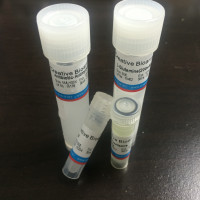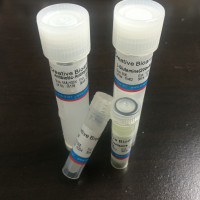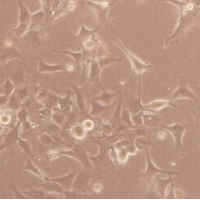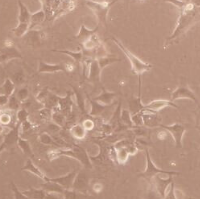293(HEK-293)细胞293(HEK-293)人胚肾细胞
Cell line name HEK293
Synonyms Hek293; HEK-293; HEK/293; HEK 293; HEK;293; 293; 293 HEK; 293 Ad5; Graham 293; Graham-293; Human Embryonic Kidney 293
Accession CVCL_0045
Resource Identification Initiative To cite this cell line use: HEK293 (RRID:CVCL_0045)
Comments Group: Vaccine production cell line.
Part of: ENCODE project common cell types; tier 3.
Part of: MD Anderson Cell Lines Project.
Registration: International Depositary Authority, American Type Culture Collection (ATCC); PTA-4488.
Biotechnology: Used for the production of the Gamaleya SARS-CoV-2 (COVID-19) vaccine (Trade name: Gam-COVID-Vac; also known as Sputnik V) (DrugBank=DB15848). Caution: we are not convinced that the cell line used for the production of this vaccine is a "plain vanilla" HEK293, it is probably an engineered derivative, but there is currently (May 2021) no precise information available on this vaccine production process.
Doubling time: ~30 hours (CLS=300192); ~24-30 hours (DSMZ=ACC-305).
Transformant: NCBI_TaxID; 28285; Adenovirus 5.
Omics: Cell surface proteome.
Omics: CTCF ChIP-seq epigenome analysis.
Omics: H3K4me3 ChIP-seq epigenome analysis.
Omics: Deep antibody staining analysis.
Omics: Deep proteome analysis.
Omics: Genome sequenced.
Omics: DNA methylation analysis.
Omics: Metabolome analysis.
Omics: Methylated arginine analysis by proteomics.
Omics: Myristoylated proteins analysis by proteomics.
Omics: Protein expression by reverse-phase protein arrays.
Omics: Transcriptome analysis by microarray.
Omics: Transcriptome analysis by RNAseq.
Omics: Virome analysis using proteomics.
Misspelling: HECK293; Note=Occasionally.
Misspelling: HEK239; Note=Occasionally.
Misspelling: HK293; PubMed=9364930.
Misspelling: HEK-393; Note=Occasionally.
Misspelling: HEK393; Note=Occasionally.
Derived from site: In situ; Fetal kidney; UBERON=UBERON_0002113
PubMed=22278370; DOI=10.1074/mcp.M111.014050; PMCID=PMC3316730
Geiger T., Wehner A., Schaab C., Cox J., Mann M.
Comparative proteomic analysis of eleven common cell lines reveals ubiquitous but varying expression of most proteins.
Mol. Cell. Proteomics 11:M111.014050-M111.014050(2012)
PubMed=23325432; DOI=10.1101/gr.147942.112; PMCID=PMC3589544
Varley K.E., Gertz J., Bowling K.M., Parker S.L., Reddy T.E., Pauli-Behn F., Cross M.K., Williams B.A., Stamatoyannopoulos J.A., Crawford G.E., Absher D.M., Wold B.J., Myers R.M.
Dynamic DNA methylation across diverse human cell lines and tissues.
Genome Res. 23:555-567(2013)
PubMed=24618588; DOI=10.1371/journal.pone.0091433; PMCID=PMC3950186
Chernobrovkin A.L., Zubarev R.A.
Detection of viral proteins in human cells lines by xeno-proteomics: elimination of the last valid excuse for not testing every cellular proteome dataset for viral proteins.
PLoS ONE 9:E91433-E91433(2014)
PubMed=25182477; DOI=10.1038/ncomms5767; PMCID=PMC4166678
Lin Y.-C., Boone M., Meuris L., Lemmens I., Van Roy N., Soete A., Reumers J., Moisse M., Plaisance S., Drmanac R., Chen J., Speleman F., Lambrechts D., Van de Peer Y., Tavernier J., Callewaert N.
Genome dynamics of the human embryonic kidney 293 lineage in response to cell biology manipulations.
Nat. Commun. 5:4767.1-4767.12(2014)
PubMed=25960936; DOI=10.4161/21624011.2014.954893; PMCID=PMC4355981
Boegel S., Lower M., Bukur T., Sahin U., Castle J.C.
A catalog of HLA type, HLA expression, and neo-epitope candidates in human cancer cell lines.
OncoImmunology 3:e954893.1-e954893.12(2014)
PubMed=25807930; DOI=10.1002/anie.201500342; PMCID=PMC4471546
Broncel M., Serwa R.A., Ciepla P., Krause E., Dallman M.J., Magee A.I., Tate E.W.
Multifunctional reagents for quantitative proteome-wide analysis of protein modification in human cells and dynamic profiling of protein lipidation during vertebrate development.
Angew. Chem. Int. Ed. Engl. 54:5948-5951(2015)
PubMed=25894527; DOI=10.1371/journal.pone.0121314; PMCID=PMC4404347
Bausch-Fluck D., Hofmann A., Bock T., Frei A.P., Cerciello F., Jacobs A., Moest H., Omasits U., Gundry R.L., Yoon C., Schiess R., Schmidt A., Mirkowska P., Hartlova A.S., Van Eyk J.E., Bourquin J.-P., Aebersold R., Boheler K.R., Zandstra P.W., Wollscheid B.
A mass spectrometric-derived cell surface protein atlas.
PLoS ONE 10:E0121314-E0121314(2015)
PubMed=25903999; DOI=10.1002/biot.201400388
Genzel Y.
Designing cell lines for viral vaccine production: where do we stand?
Biotechnol. J. 10:728-740(2015)
PubMed=27233776; DOI=10.1002/pmic.201500349
Lobas A.A., Karpov D.S., Kopylov A.T., Solovyeva E.M., Ivanov M.V., Ilina I.Y., Lazarev V.N., Kuznetsova K.G., Ilgisonis E.V., Zgoda V.G., Gorshkov M.V., Moshkovskii S.A.
Exome-based proteogenomics of HEK-293 human cell line: coding genomic variants identified at the level of shotgun proteome.
Proteomics 16:1980-1991(2016)
PubMed=27577262; DOI=10.1126/scisignal.aaf7329
Larsen S.C., Sylvestersen K.B., Mund A., Lyon D., Mullari M., Madsen M.V., Daniel J.A., Jensen L.J., Nielsen M.L.
Proteome-wide analysis of arginine monomethylation reveals widespread occurrence in human cells.
Sci. Signal. 9:Rs9.1-Rs9.15(2016)
PubMed=28196595; DOI=10.1016/j.ccell.2017.01.005; PMCID=PMC5501076
Li J., Zhao W., Akbani R., Liu W.-B., Ju Z.-L., Ling S.-Y., Vellano C.P., Roebuck P., Yu Q.-H., Eterovic A.K., Byers L.A., Davies M.A., Deng W.-L., Gopal Y.N.V., Chen G., von Euw E.M., Slamon D.J., Conklin D., Heymach J.V., Gazdar A.F., Minna J.D., Myers J.N., Lu Y.-L., Mills G.B., Liang H.
Characterization of human cancer cell lines by reverse-phase protein arrays.
Cancer Cell 31:225-239(2017)
DOI=10.13005/bpj/1414
Yuan J., Xu W.W.-Y., Jiang S.Y.-L., Yu H.X.-Y., Poon H.-F.
The scattered twelve tribes of HEK293.
Biomed. Pharmacol. J. 11:621-623(2018)
PubMed=29660373; DOI=10.1016/j.bbagen.2018.04.012
Touat-Hamici Z., Bulteau A.-L., Bianga J., Jean-Jacques H., Szpunar J., Lobinski R., Chavatte L.
Selenium-regulated hierarchy of human selenoproteome in cancerous and immortalized cells lines.
Biochim. Biophys. Acta 1862:2493-2505(2018)
PubMed=30260228; DOI=10.1021/acs.jproteome.8b00538
Knott M.E., Manzi M., Zabalegui N., Salazar M.O., Puricelli L.I., Monge M.E.
Metabolic footprinting of a clear cell renal cell carcinoma in vitro model for human kidney cancer detection.
J. Proteome Res. 17:3877-3888(2018)
PubMed=32302230; DOI=10.1089/hum.2020.29116.oxg
OXGENE
Live and let live: the remarkable story of HEK293 cells.
Hum. Gene Ther. 31:485-487(2020)















